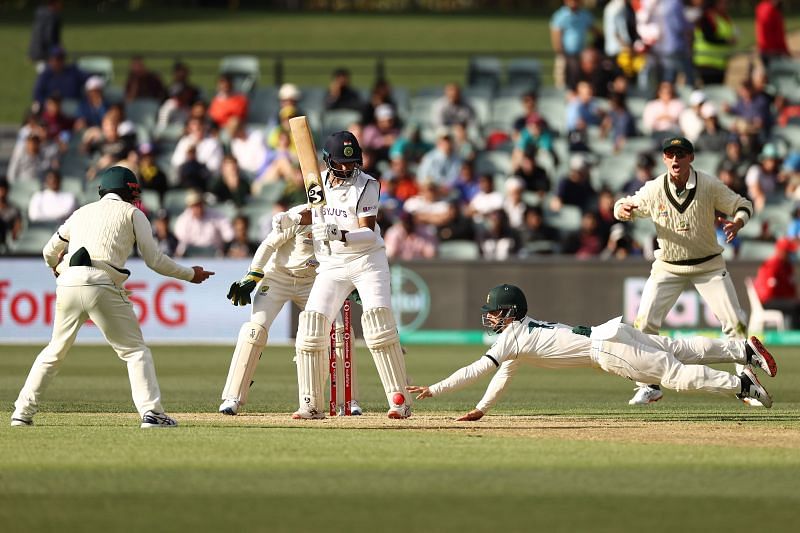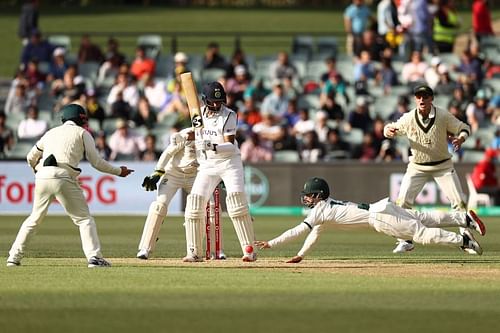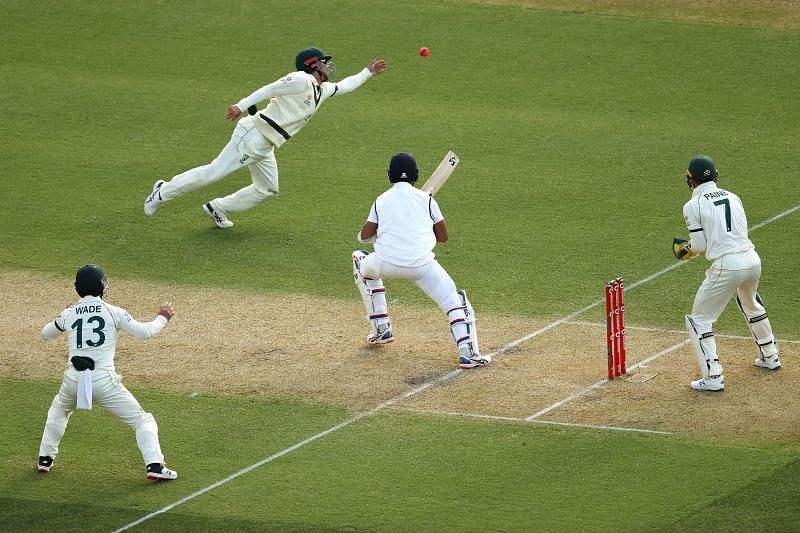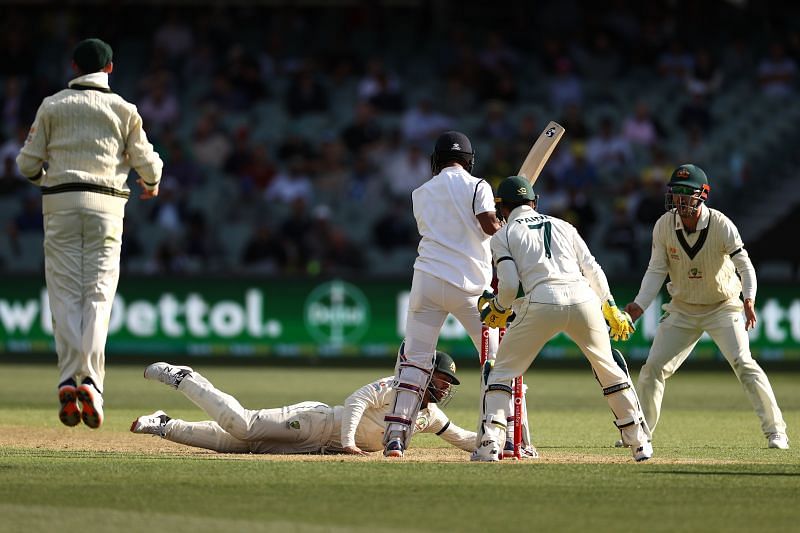
IND v AUS 2020: Could Cheteshwar Pujara's slow batting approach cost India at Adelaide?

A couple of deliveries into the 1st Test between India and Australia, the former found itself staring at a familiar barrel, especially in overseas conditions. Prithvi Shaw, after surprisingly receiving a long rope, had chewed through most of it and produced another self-inflicted dismissal, with his lack of foot movement being woefully exposed by Mitchell Starc.
At that juncture, India’s crisis man aka Cheteshwar Pujara walked in – something that was eerily similar to what had transpired on the Men In Blue’s last tour Down Under. Unfortunately, though, he couldn’t churn out the number of runs he was expected to. In fact, on the flip side, his innings had a slightly counterproductive effect.
Cheteshwar Pujara came out to bat in the very first over and that that point, the pitch was offering some sort of assistance to the bowlers. Unsurprisingly, Cheteshwar Pujara decided to buckle down and barely allowed the Australians any further inroads into the Indian batting line-up.
To put things into further perspective, the right-hander crawled to 17 off 88 balls at the end of the first session – emphasizing the hard yards he had put in, while watching two of his partners perish to the seaming ball.

Post that though, when the conditions started easing up, Cheteshwar Pujara continued ambling along and if one were a tad critical, he was guilty of showing too little intent. Ultimately, he departed having scored 43 off 160 deliveries. And, though he batted 218 minutes and sapped a bit of energy out of the Australian bowlers, it dug a hole for the Indians as well.
In the second session, which has historically been the best time to bat, especially in pink-ball cricket, Cheteshwar Pujara only scored 13 runs in 57 balls, between the 26th and the 46th over. During that period, the ball had stopped seaming, with Nathan Lyon content to hold one end up.
Throughout his Test career, Cheteshwar Pujara has been a better run accumulator against slow bowling, often opting to ride the fast-bowling storm before capitalizing against the spinners. This time though, he unnecessarily went into a shell against Nathan Lyon and allowed the Australian to dictate the tempo of the game.
For large swathes of his essay, Cheteshwar Pujara was content to kick balls away and not use his feet. While the former has regularly been a trait of his batting technique, the decision to not use the latter certainly rid Cheteshwar Pujara of the usual bite he has, when tackling spinners.
Consequently, Nathan Lyon settled into a rhythm and bowled most of his deliveries on a good length outside off stump.
Though one doesn’t expect Cheteshwar Pujara to dance down the track frequently and impose himself on the encounter, the least he could’ve done was rotate the strike. In turn, that would’ve ensured that the Australian bowlers would’ve kept sifting through different plans, considering Virat Kohli and Cheteshwar Pujara possess drastically different challenges.
Cheteshwar Pujara batted a lot slower than usual
As far as numbers are concerned, Cheteshwar Pujara was en route his slowest ever Test fifty, had he gotten to that mark in more than 173 balls. And, he also hit his first boundary on the 148th delivery he faced, highlighting the slightly lackadaisical approach.
Additionally, once Cheteshwar Pujara was back in the shed, the Indians, with Ajinkya Rahane and Virat Kohli at the crease, looked a lot more potent and seemed to put the Australians under much more pressure. While neither particularly set the world ablaze with their strike rates, both weren’t guilty of getting stuck.

In fact, the pair kept the scoreboard ticking and pounced on whatever loose deliveries the Australians served up – a feature that was distinctly missing from Cheteshwar Pujara.
In fact, despite Cheteshwar Pujara not preferring to attack, he accorded the hosts plenty of look-ins, thereby indicating that he wasn’t particularly in control for the duration of his innings.
There were at least 3 or 4 previous occasions when Cheteshwar Pujara could have been dismissed, with the lack of bounce and pace proving to be the Indian’s saviours. Thus, it seemed only a matter of time before he was sent packing and due to the lack of runs, he had scored, one felt it would only magnify the gravity of the situation. And, those notions were vindicated.
In previous pink-ball Tests at Adelaide, the mantra has been to soak up the pressure at the start and the end of the day and cash in while the tide is a lot simpler during the afternoon session. To aid that argument, a major chunk of the substantial innings played during these contests have followed that tactic.

Faf du Plessis did so against Australia in 2016, Usman Khawaja repeated the dose in the same game, Shaun Marsh provided a similar template against England in the Ashes in 2017. More recently, David Warner and Marnus Labuschagne ripped through the Pakistan bowling line-up via that modus operandi.
On Thursday though, Cheteshwar Pujara was left ruing a lack of intent as the game passed him by, meaning that when he did get out, India didn’t particularly have a daunting total on the board. Or, a score that could’ve transferred pressure onto Australia, at the very least.
Though there might be a temptation to label Virat Kohli’s run-out or Ajinkya Rahane’s dismissal as the moment when the tourists handed the hosts the initiative, it was perhaps the sluggishness of Cheteshwar Pujara’s innings that pumped the wind into the Australian sails.
To put things more bluntly, the Aussies, despite being diligent with their lines and lengths, were allowed to do so, courtesy the Indian’s trepidation in the opening couple of sessions.
And, owing to that bit of indecisiveness, the tourists, although they seemed comfortable for large portions of Day 1, still find themselves reeling at 233/6 on a surface that is perhaps the most docile the Adelaide Oval has ever served up in a pink-ball fixture.
Understandably, it would be quite naïve to expect Cheteshwar Pujara to change his batting philosophy overnight. In fact, one wouldn’t really want that as well, considering he usually finds himself in the eye of the storm.

Yet, on this particular occasion, it could just prove to be the Indian outfit’s undoing, not just because of the pitch and the novel dimensions of pink-ball cricket, but also because of the unforgiving nature of the opposition. Additionally, in Day-Night Tests, even the slightest bit of ordinariness could get punished.
Having said that, the Indians could still conjure a stirring lower-order rear-guard action and take the game away from Australia. Or, Messrs. Jasprit Bumrah and Mohammed Shami could rock up at Adelaide and blow the hosts away.
But those prospective situations might’ve been made a shade more difficult, especially with India six down and more importantly, with them not having a lot of runs on the board.
And, it seems rather ironic that Cheteshwar Pujara - the man who was lauded as one of the cornerstones of India’s triumph Down Under in 2018-19 might just have put his side behind the eight-ball, despite scoring runs.
The game of cricket never ceases to amaze, does it?